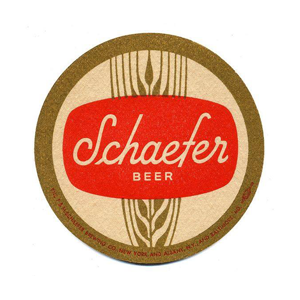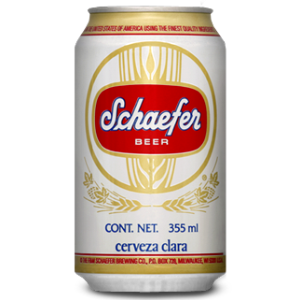F. & M. stands for Frederick and Maximilian, the brothers who founded Schaefer. Frederick Schaefer, a native of Wetzlar, Prussia, Germany, emigrated to the U.S. in 1838. His younger brother, Maximilian, decided to make the arduous trip across the Atlantic in 1839 and brought with him a formula for lager, a type of beer popular in Germany but unheard of in the United States. The brothers dreamed, and planned, and saved - and in the late summer of 1842 they were able to buy a small brewery from Sommers.
New York beer drinkers immediately took a liking to "the different beer" the brothers brewed, and in 1845 Frederick and Maximilian developed a new plant several blocks away. This proved to be just a temporary move; the plant was almost immediately inadequate to meet demands and the brothers wisely decided to build yet another new plant, and to locate it in an area where they could expand as needed. Their search took them to what were then the "wilds" of uptown Manhattan. In 1849 the brewery, lock, stock and many barrels, was moved just north of Grand Central Station, where the Schaefer's brewed for the next 67 years, ever-expanding their plant. Rudolph J. Schaefer assumed the Presidency of the brewery in 1912 after the passing of Frederick and Maximilian. In 1915, Rudolph constructed the very best in pre-Prohibition breweries. While it must have seemed a real shame to brew "near beer" in his spanking new plant, Rudolph Schaefer obviously felt that near beer was better than no beer at all; consequently, the brewery remained in operation all during Prohibition, producing mostly near beer but also manufacturing dyes and artificial ice.
In 1923 Rudolph J. Schaefer passed away at the relatively young age of 60. Control of the company thus passed to his two sons, Frederick M.E. Schaefer and Rudolph J. Schaefer, Jr. Frederick guided the brewery for several years, but in 1927 Rudolph Jr. was elected President. Although he was by far the youngest brewery President in the United States, Rudy, Jr. provided excellent leadership. Sales continued strong throughout the 1940's and, to increase capacity, Schaefer purchased the former Beverwyck Brewery Co. in Albany, New York in 1950. They remained a two-plant company until 1961 when, with an eye toward expanding into large areas of the mid-west, Rudy Schaefer purchased the Standard Brewing Company, of Cleveland, Ohio.
Schaefer's most dramatic move with respect to plants was the decision, in 1971, to build a brand new, ultra-modern brewery just outside of Allentown, Pa. A new brewery was opened in 1972. The Lehigh Valley plant was one of the most modern and efficient breweries in the world. The Albany plant was shut down almost immediately. In 1974 the Lehigh Valley plant was expanded, and in 1975 it was expanded again - to a capacity of 5,000,000 barrels plus. By 1975, it was obvious that one of less efficient plants would be closed. In 1976 Schaefer announced the closing of the Brooklyn plant. This announcement, only one week after Rheingold disclosed its plans to also shut down in Brooklyn, left Brooklyn and New York City without a single producing brewery.
In 1981, the F. & M. Schaefer Brewing Company was purchased by the Stroh Brewery Company. In 1999, the Stroh Brewery Company was bought by the Pabst Brewing Company which continues to sell Schaefer Beer today.
New York beer drinkers immediately took a liking to "the different beer" the brothers brewed, and in 1845 Frederick and Maximilian developed a new plant several blocks away. This proved to be just a temporary move; the plant was almost immediately inadequate to meet demands and the brothers wisely decided to build yet another new plant, and to locate it in an area where they could expand as needed. Their search took them to what were then the "wilds" of uptown Manhattan. In 1849 the brewery, lock, stock and many barrels, was moved just north of Grand Central Station, where the Schaefer's brewed for the next 67 years, ever-expanding their plant. Rudolph J. Schaefer assumed the Presidency of the brewery in 1912 after the passing of Frederick and Maximilian. In 1915, Rudolph constructed the very best in pre-Prohibition breweries. While it must have seemed a real shame to brew "near beer" in his spanking new plant, Rudolph Schaefer obviously felt that near beer was better than no beer at all; consequently, the brewery remained in operation all during Prohibition, producing mostly near beer but also manufacturing dyes and artificial ice.
In 1923 Rudolph J. Schaefer passed away at the relatively young age of 60. Control of the company thus passed to his two sons, Frederick M.E. Schaefer and Rudolph J. Schaefer, Jr. Frederick guided the brewery for several years, but in 1927 Rudolph Jr. was elected President. Although he was by far the youngest brewery President in the United States, Rudy, Jr. provided excellent leadership. Sales continued strong throughout the 1940's and, to increase capacity, Schaefer purchased the former Beverwyck Brewery Co. in Albany, New York in 1950. They remained a two-plant company until 1961 when, with an eye toward expanding into large areas of the mid-west, Rudy Schaefer purchased the Standard Brewing Company, of Cleveland, Ohio.
Schaefer's most dramatic move with respect to plants was the decision, in 1971, to build a brand new, ultra-modern brewery just outside of Allentown, Pa. A new brewery was opened in 1972. The Lehigh Valley plant was one of the most modern and efficient breweries in the world. The Albany plant was shut down almost immediately. In 1974 the Lehigh Valley plant was expanded, and in 1975 it was expanded again - to a capacity of 5,000,000 barrels plus. By 1975, it was obvious that one of less efficient plants would be closed. In 1976 Schaefer announced the closing of the Brooklyn plant. This announcement, only one week after Rheingold disclosed its plans to also shut down in Brooklyn, left Brooklyn and New York City without a single producing brewery.
In 1981, the F. & M. Schaefer Brewing Company was purchased by the Stroh Brewery Company. In 1999, the Stroh Brewery Company was bought by the Pabst Brewing Company which continues to sell Schaefer Beer today.
There are no reviews for this item.



